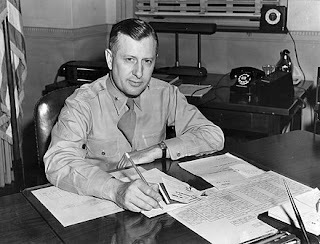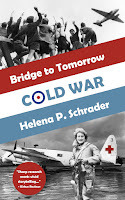Historical Characters in "Cold War" - General William H. Tunner
No novel about the Berlin Airlift could make any claim to accuracy and authenticity without including General William H. Tunner. Although his influence was felt only in stages, as he was granted increasing authority, he was the world's greatest expert in military air transport. As Commander of the Combined Airlift Taskforce, Tunner took charge of the Airlift and imprinted his own character upon it. His innovations and his forceful personality saved the Airlift from chaos and collapse at a critical juncture.

Tunner had beenone of the first officers in the entire Air Force to specialise in airtransport. He had helped establish the Ferrying Division and nurtured it from ahandful of men to an organisation 50,000 strong and delivering 11,000 planes amonth to domestic and overseas destinations. In fact, he can be largelycredited with creating not only an organisation but an entire ethos andstandard for air transport pilots. He passionately believed that transportpilots had a different mission and required different qualities than combatpilots. He was proud to claim that he had “proved that air transport was ascience in itself; to be carried out at its maximum efficiency air transportmust be run by men who … are dedicated to air transport – professionals.” [Tunner, Over the Hump, Office of Air Force History, 1964, p. 41] He had then, in August1944, taken command the highly risky supply operation across the Himalayas – which had already defeated several previouscommanders – and turned it into a spectacular success.
Tunner also had areputation as a hard driver. His nickname was “Willy the Whip” and he claimedhe didn’t lose any sleep over it. The official air forcehistory of Air Transport Command described him as “arrogant, brilliant,competent. He was the kind of officer whom a junior officer is well advised tosalute when approaching his desk.” In short, he was boththe consummate professional air transport commander and the kind of commanderwho could be expected to get the job done – even if it was a job that theofficers appointing him did not believe could be done. For more details on his impact on the Berlin Airlift see: Tunner Takes Command.
The below excerpt depicts a first meeting between General Tunner and the RAF Station Commander Gatow, my fictional character Robin Priestman. This scene is set on August 14, a time when the airlift operations of Britain and the United States were still independent, i.e. before the formation of the Combined Airlift Task Force and before Tunner became Priestman's indirect superior.
The USAF C-54 settled down at Gatowfour minutes late and was led by the “Follow-Me” Land Rover to a hardstandingwhere Priestman awaited. The engines had not stopped spinning before the dooropened and a US general in a khaki uniform and polished shoes jumped down ontothe tarmac. He was trim, modestly good-looking with regular features, and abusinesslike rather than a friendly demeanour. He returned Priestman’s salute, andhe offered his hand with the words, “Thank you for seeing me at such shortnotice, Wing Commander.”
“Everything is short notice on thisAirlift,” Priestman replied. “How can I help you?”
“Oh, I just thought I’d take a look atyour operations and see how you were handling things. If you’ll wait onemoment, my pilot and copilot are two of my staff officers. I want them to joinus.” He looked toward the aircraft and on cue, two lieutenant colonels droppedout of it to be introduced as Bettinger and Foreman.
Priestman reciprocated by introducing,“Captain Bateman, RASC, responsible for our Forward Area Supply Organization orFASO. That is, everything to do with unloading the aircraft and moving the cargoesup to Berlin.” Priestman drew attention to the fact that Tunner’s aircraft wasalready being unloaded.
Tunner turned to watch as the trailerwas backed up against the cargo door of his Skymaster. “I see you’re usingGerman stevedores, just as we do. Any problems with them?” he asked.
Priestman nodded to Bateman to answer.
“None at this end. In the early days,German loaders were didn’t understand that the cargo capacity of aircraftvaries. They knew even less about maintaining the aerodynamics of the aircraftby careful distribution of loads. Those teething problems have since been resolved.”…
Tunner snorted but nodded hisunderstanding, then looked at Priestman. Taking this to mean Tunner wasfinished with the topic of unloading, Priestman invited the Americans into hiscar and drove them over to the maintenance hangar. Here Tunner and his staffofficers met Gatow’s Chief Engineering Officer, Squadron Leader Holt. Tunner’ssharp eye rapidly noted, “You don’t have many aircraft in maintenance andalmost no spare parts inventory. Why is that?”
“All Airlift aircraft are based in theWest and that is where routine maintenance is carried out. We only maintain alimited supply of those essential components most likely to require immediatereplacement such as tyres, brakes, etc.”
“What if an aircraft lands with adifferent problem?” Tunner asked, adding, “You seem to have ample hangar spaceto manage much more maintenance.”
“Our problem isn’t space butpersonnel. We only have enough ground crew here to handle an emergency. As forspare parts, the RAF doesn’t have infinite stockpiles and what we have iscentralised at our main depot in the UK. If we lack something, it can be flownin within a couple of hours — a day at the most. As a rule, however, we preferan aircraft’s regular crew to handle all repairs during routine maintenance.”
“You have crews assigned to individualaircraft?” Tunner sounded surprised.
“That’s right.”
“Isn’t that a waste of manpower?”Although his expression was impassive, his disapproval was evident.
“How so, sir?” Holt asked defensively.
“Well, 50-hour checks only come due everyfive or six days. What is the crew doing in the meantime?”
Priestman took over from the rattledHolt, “Squadron ground crews handle two aircraft each and the RAF requiresdaily inspections. In addition, squadron ground crews do the 150-hourinspections which come up roughly every fortnight. Our ground crews are workingtwelve-hour days. There’s no question of them lazing about.”
“You still do daily inspections? Thatseems over-cautious. We’ve found fifty-hour checks are adequate to correctminor issues and identify major ones,” Tunner countered.
Priestman was unimpressed. “Ourphilosophy is to carry out preventive not merely corrective maintenance. Weprefer repairing an item in time rather than waiting for it to break down andneed replacing.”
“That sounds like an admirableapproach in peacetime, Wing Commander, but in war — or warlike conditions suchas we have here — the primary concern must be maximum utilization of assets.That means aircraft should be flying, loading/unloading or undergoingmaintenance. They shouldn’t be sitting around on the ground being inspected forproblems they don’t yet have. My preference is to give them a thorough check at200 hours. I’ve arranged for the C-47s to go down in Oberpfaffenhofen and theC-54s to fly to Burtonwood.”
That sounded as though it would takeaircraft off the Airlift longer than the RAF’s daily inspections, but Priestmanchose not to challenge the “expert.” Instead, he suggested they move on.
The tour continued to the MalcolmClub. Priestman explained that station personnel used the messes, while theMalcolm Club served the crews waiting for their aircraft to be unloaded. “TheSalvation Army, NAAFI and YMCA also offer quick snacks from mobile canteens onthe airfield or beside the maintenance hangars, but here men can sit down andget a bit of peace and quiet. They also have a barber shop if someone wants ahaircut while waiting, and the lounge is well-stocked with newspapers andperiodicals.” Priestman proudly pointed to a table where these were displayed.“If an aircraft is stranded here overnight, the club offers limited butcomfortable accommodation.”
Tunner looked around the roomcritically. “The problem with nice places like this is that the crews get tochatting and smoking and reading when they ought to be flying. As of yesterday,my crews have orders not to move more than 10 feet away from their aircraft.”
“I’m sure that’s popular,” Priestmannoted.
“I’m not here to win a popularitycontest,” Tunner shot back. “As I said a moment ago, I want maximum utilizationof assets, and that includes pilots.”
“And how do they get the weatherreport and file a return flight plan?”
“I send a jeep around with theoperations officer, another with the weather report, and finally, a mobilesnack bar manned by the prettiest girls the Red Cross could recruit in Berlindrives from plane to plane. The men don’t seem to be bitching too much.”
Priestman nodded acknowledgementrather than approval and asked if his guests wanted a tour of the full stationincluding accommodations, messes, and recreational facilities, or if theypreferred to go straight over to the meteorology section, operations room andthe tower. Unsurprisingly, Tunner opted for the latter.
As they mounted the steps of the mainbuilding, Tunner remarked, “I’ve asked my staff to work out new trafficpatterns in the corridors, and I hope the RAF will cooperate… For a start,one-way traffic. Everything flies in via the northern and southern corridorsand out via the central corridor.”
“That would be a great improvement andsomething I suggested long ago,” Priestman noted dryly. Tunner gave him asecond look, but Priestman kept his eyes averted.
Tunner continued, “You’ve probablyalready heard that I’ve ordered all pilots who miss a landing to return fullyloaded to avoid stacking up aircraft in the limited airspace over Berlin — andwoe betide any pilot who misses his landing without good reason!”
Priestman nodded without commentary.He was not as averse to stacking aircraft as Tunner and felt sending loadedaircraft back was a waste of aviation fuel that also delayed the delivery ofdesperately needed supplies to Berlin. He conceded that in a situation such ashad developed at Tempelhof yesterday, it was preferable to an accident, but hethought the decision should be made on a case-by-case basis.
Tunner next remarked, “I’ve asked thePentagon to call up one hundred civilian air traffic controllers and send themover to improve the quality of the ATC. Some of our guys just aren’texperienced enough for this environment.”
Priestman nodded agreement wordlessly.
Tunner wasn’t finished, “I’ve also putin a formal request via General LeMay to Air Marshal Sanders to base a bunch ofour aircraft in your Zone.”
That brought Priestman to a halt, andhe looked over at the American surprised.
“Look, the distance to Berlin fromeither Wiesbaden or Rhein-Main is roughly 300 miles while it’s just over 120miles from Celle or Fassberg and less than 100 from Hamburg. The same aircraftcan make three trips to Berlin from Fassberg in the time it takes to make twosorties from Rhein-Main. That’s 50% more.”
Priestman nodded and conceded, “Thatmakes sense.”
“What it means is that most of thoseplanes will be funnelled down the northern corridor and directed into Gatow,starting one week from today.”
“Ah, I see. That’s why you were sokeen to visit,” Priestman concluded with a faint smile.
“That was one reason. The other is thata C-74 is arriving today at Rhein-Main with vitally needed engines and otherbulky replacement parts. Some genius in the Pentagon came up with the idea ofstuffing it full of flour — after we’ve unloaded those special cargoes — andsending it on to Berlin. The problem with that is it’s far too heavy to land onthe PSP runways at Tempelhof. If we’re going to make a show — and that’s allthis is since the brass refuses to dedicate any C-74s to the Airlift — it isgoing to have to take place here at Gatow.”
“I see,” Priestman commented dryly. Hedidn’t like having something like this sprung on him at such short notice.
Tunner could read his mood and triedto make the event more palatable. “It wasn’t my idea, but to be fair, somethinglike this will highlight that this is a joint effort — even if it is still,irrationally, two separate operations.”
Intentionally or not, Tunner had justshown his hand. The American general wanted a combined operation. Morespecifically, he wanted to control not just the U.S. aircraft and airfields butthe British ones as well. That way they would all have to dance to his tune.
Priestman had mixed feelings aboutthat. He could see the sense in many of Tunner’s suggestions and disliked Bagshot’ssmall-minded approach to problems. Yet the American general also struck him as rigidand adverse to alternative approaches. Tunner appeared to believe he had allthe answers already. Most damning, his obsession with “maximum utilization ofassets” struck Priestman as almost inhuman.
Tunner, P. 41.
Tunner, p. 110.
Oliver LaFarge, The Eagle inthe Egg, p.26.
Tunner is a character in the Second two volumes of the Bridge to Tomorrow Trilogy
Berlin is under siege. More than twomillion civilians must be supplied by air -- or surrender to Stalin's oppression.
USAF Captain J.B. Baronowsky and RAF FlightLieutenant Kit Moran once risked their lives to drop high explosives on Berlin.They are about to deliver milk, flour and children’s shoes instead. Meanwhile,two women pilots are flying an air ambulance that carries malnourished andabandoned children to freedom in the West. Until General Winter deploys on theside of Russia. Buy now!
Based on historical events, award-winning and best-selling novelistHelena P. Schrader delivers an insightful, exciting and moving tale about howformer enemies became friends in the face of Russian aggression — and how closethe Berlin Airlift came to failing.
Winning a war with milk, coal and candy!




